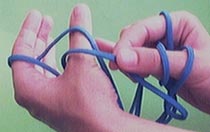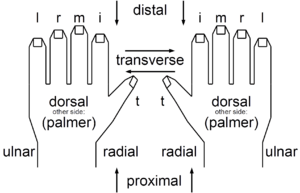String figure facts for kids

A string figure is a design you make by moving a piece of string around your fingers. Sometimes, you might even use your mouth, wrists, or feet! String figures can be single pictures, or they can be part of a game or a story. When they are part of a game, it's called a string game. If you make many figures one after another to tell a story, it's a string story.
One very popular string game is cat's cradle. Many string figures are known all over the world, often with different names in different places.
The History of String Figures
We don't know exactly when people first started playing with string. But we do know that people in ancient societies used string for many things, like hunting, fishing, and weaving. String figures have been found in native cultures all around the world.
String figures are thought to be one of humanity's oldest games. They are played by many different cultures, even ones that are very far apart. For example, in the 1800s, a traveler named Alfred Russel Wallace was surprised when he tried to teach a new string game to the Dayak people in Borneo. They already knew it and showed him even more figures he had never seen!
Another interesting story comes from the anthropologist Louis Leakey. He said that knowing string figures helped him travel safely in Africa in the early 1900s. His teacher, Alfred Cort Haddon, told him, "You can travel anywhere with a smile and a piece of string."
The first known written description of a string figure comes from a Greek doctor named Heraklas in the first century. He wrote about a figure called the "Plinthios Brokhos". This figure was used as a sling to help set a broken jaw. People have found that this same figure is known by Indigenous Australians as "The Sun Clouded Over."
Scientists called anthropologists studied string figures a lot from the 1880s to about 1900. They hoped to learn about how different cultures developed. Many figures were collected and described from places like Southeast Asia, Japan, South America, the West Indies, and among Pacific Islanders and Native Americans.
Today, the International String Figure Association (ISFA) was started in 1978. Their main goal is to collect, save, and share knowledge about string figures. This way, future generations can keep enjoying this ancient and fun pastime.
Making String Figures
When you make string figures, there are special ways to hold and move the string. A "loop" is the string that goes around a finger or another part of your body, like your wrist.
Some common ways to start a string figure are called "openings." For example, "Opening A" is a popular way to begin many figures. There are also specific "moves" you use to change the string's shape. One common move is called the Navajo leap, where a lower loop of string is moved over an upper loop and off your finger.
These special openings and moves help you create all the different and amazing string figures!
See also
 In Spanish: Juego del cordel para niños
In Spanish: Juego del cordel para niños





